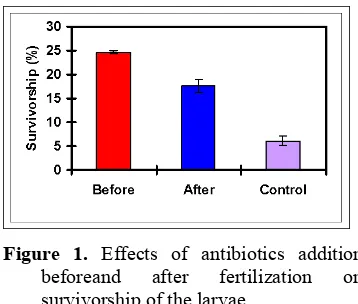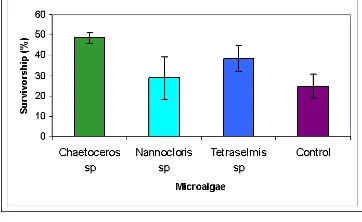IMPROVING SURVIVORSHIP OF GIANT CLAMS
LARVAE
Ambariyanto
Marine Science Department, Faculty of Fisheries and Marine Sciences Diponegoro University, Semarang, Indonesia, ambariyanto@telkom.net
Abstract
One of the problems faced in giant clams culture is high mortality rate during larvae stages. These series of research attempt to improve survivorship of giant clams larvae by several different treatments, such as applying antibiotics, nutrient addition, feeding with different microalgae, and introduction of zooxanthellae at different time. The results show that survivorship was significantly improved by applying Streptomycin (10 ppm) before fertilization and when it is combined with Chloramphenicol (5 ppm). Ammonium addition was also increased survivorship of giant clams larvae. On the other hand, feeding with different microalgae was not significantly improved the larvae survivorship. Introducing zooxanthellae at early stage before metamorphosis (day 3 – 4) was also improving survivorship of the larvae.
Keywords: giant clams, growth, suvivorship, aquaculture
1. Introduction
Many invertebrates, such as hermatypic corals, anemonies, jellyfish and giant clams, are known to live in association with endosymbiotic algae, usually referred to zooxanthellae. In giant clams (Family: Tridacnidae) zooxanthellae is found in the mantle of the clams. These algae have an important role on the nutrition of their hosts by translocating part of their photosynthetic results to their hosts. Therefore, the growth and survivorship of the clams is greatly influenced by zooxanthellae (Fitt, 1993; Ambariyanto, 1997).
Reports stated that the natural populations of giant clam in Indonesia declined rapidly which mainly due to over exploitation (Brown and Muskanofola, 1985; Pasaribu, 1988, Ambariyanto et al., 2000). Efforts have been made to overcome this problem, such as putting giant clams in the list of endangered species so that they can not be taken from natural population,
producing giant clams larvae in hatcheries, and also restocking projects.
Some basic problems remain, however, especially in the hatchery operation. The survivorship and growth rate of giant clams larvae have been found to be very limited. The mortality rate of these larvae is approximately 70 % when they reach metamorphosis stage (Beckvar, 1981; Braley, 1992). Less than 5 % of the larvae will reach 5 mm in shell length, and less than 1 % of the larvae will reach adult stage. Furthermore, the growth rate of these larvae is also very low. These larvae will reach 5 mm in shell length after 3-6 months and 10 mm in shell length after 1 to 1.5 year depending on the species of the giant clams (Beckvar, 1981; Braley, 1992). Therefore, study to improve the growth and survivorship of giant clams larvae need to be done.
2. Methodology
Larvae production
Larvae were produced by induce to spawn of adult clams using serotonin (Braley, 1985). Fertilization was done in concrete tanks and the hatching rate during this study was found to be relatively high, i.e. 70% at trochopore stage (Ambariyanto et al., 1999).
Antibiotic addition
First experiment: Streptomycin (Meiji; 10 ppm) was added at (a) before fertilization, (b) after fertilization, and (c) control i.e. without antibiotic addition.
Second experiment: three different treatments were conducted i.e. (a) Streptomycin (10 ppm), (b) Chloramphe-nicol (5 ppm) and (c) combination those two antibiotics. These antibiotics were given after fertilization.
Zooxanthellae introduction
Zooxanthellae used in this experiment were isolated from Tridacna squamosa, T. maxima, and coral, Goniopora sp. Zooxanthellae from three different sources were given before metamorphoses at day 4, 6, 9, 10, 12. For control, zooxanthellae (only from T. squamosa) were given after metamorphoses at day 12, 13, and 14. The number of larvae were counted daily for 34 days. At the end of the experiments the size of the larvae was also measured.
Nutrient addition
Three treatments (inorganic nutrient addition i.e. N, P and N+P) and control (without any nutrient addition) were carried out with three reaplicates. Final concentration of nutrient given were 20µM for N (ammonium; NH4Cl) and 2µM for P (phosphorus; KH2PO4).
Microalgae addition
The microalgae used in the present study were (1). Chaetoceros sp; (2). Nannochloris sp.; (3) Tetraselmis sp., and control (without microalgae addition) These
microalgae were given to two (2) days old larvae until metamorphoses.
Statistical analysis of data.
Analysis of variance (ANOVA) will be used to analyse the data collected. Homogeneity of variances will be tested prior to ANOVA. Differences among the means will be tested by Student Newman Keuls test (Underwood, 1981).
3. Results and Discussion
Antibiotics addition
At the moment, one of the problems faced by giant clams aquaculture industry is high mortality rate of the larvae which can reach 90-95 % (Fitt and Trench, 1981). Antibiotics have been used as hatchery pratices to increase the survivorship of the larvae (Norton et al., 1993 a,b). Fitt et al. (1992) stated that streptomicyn application in the larval tanks gave better survivorship than other antibiotics, such as neomycin, pinicylin dan rifampin. The best concentration of streptomycin which can be applied is 10 ppm (Fitt et al., 1992).
The results of this study showed that applying antibiotics before fertilization will increase the survival rate of the larvae. At the end of the experiment, it was found that the addition of antibiotic before fertilization significantly increased the survivorship of the larvae (P=6.47E-05). See Figure 1. (Ambariyanto et al., 1999).
Figure 1. Effects of antibiotics addition beforeand after fertilization on survivorship of the larvae
The results of the second experiment showed that the addition of antibiotic in combination (streptomycin dan chloramphenicol) significantly increase the survivorship of the larvae compared with those added with sigle antibiotic (P=0.02). At the end of the experiment, the highest survivorship was 57,4 % (combination of streptomycin and chloramphenicol), followed by 46,1 % (streptomycin) and 32,4 % (control) and 30,4 % (chloramphenicol). See Figure 2. (Ambariyanto, 2000).
Figure 2. Effects of antibiotics addition in separate and combination on the survivorship of the larvae
Zooxanthellae introduction
The results of the present study showed that introducing zooxanthellae before metamorphoses significantly increase the survivorship and growth rate of giant clams larvae (P=0,0002), except those
introduced by zooxanthellae isolated from corals. See Figure 3.
Figure 3. Effects of zooxanthellae introduction isolated from different sources before and after metamorphoses on the size of the larvae
Similarly, the shell length of the larvae introduced by zooxanthellae before metamorphoses significantly longer than those introduced with zooxanthellae after metamorphoses (P=6,8E-06). The largest larvae was found on those introduced with zooxanthellae isolated from clams Tridacna squamosa, followed by those introduced with zooxanthellae of T. maxima and corals, Goniopora sp. See Figure 4.
Figure 4. Effects of nutrients addition on the size of the larvae
These results suggest that introduction of zooxathellae before metamorphoses should be used in giant clams hatchery stardard procedures (Ambariyanto, 2000).
Nutrient addition
The results of the present study show that addition of inorganic nutrient, especially N (ammonium) increased the shell length of giant clams juvenil. Compared with control, the shell length increment of N treated clams were almost seven times higher. The influenced of the addition of P (phosphorus), however, was much less than that of N addition (almost 9 fold less).
Figure 5. Effects of microalgae addition on the survivorship of the larvae
Inorganic nutrient addition, especially N, increase the growth rate of giant clams juvenil. Figure 5 shows juvenile which grown in the water added with N have significantly longer shell length compared with those other treatments and control (P= 4.6E-06). This result is in accordance with other reports which showed that nutrient addition in the water have increased the number of corals zooxanthellae (Hoegh-Guldberg 1994), as well as adult giant clams, Tridacna maxima (Ambariyanto and Hoegh-Guldberg, 1997).
Microalgae addition
The main sources of giant clams nutrition are from photosynthate translocation by zooxanthellae and filter feeding habit (Fitt, 1993; Ambariyanto, 1997). In addition, microalgae are important natural food of giant clams which is ingested through filter feeding activity (Klumpp et al., 1992). However, microalgae which gives best influence to giant clams larvae is not yet known.
The results of the present study showed that all larvae fed by different microalgae and unfed larvae (control)
reached metamorphoses. This suggests that until the larvae reach metamorphoses, external feeding with microalgae becomes optional clams hatchery practice. Therefore, in order to minimise the production cost in the hatchery, feeding by microalgae on giant clams larvae do not need to be done.
One important aspect which worth to be noted is that, although feeding of different microalgae statistically not significantly influenced the survivorship of clams larvae, feeding with Chaetoceros sp. gave a better survival rate compared with other species and control. See Figure 6. Secondly, unlike the report by Gwyther dan Munro (1981) and Southgate (1988) which say that unfed clams larvae will not reach metamorphoses, the present study found that the clams larvae both fed with microalgae (treatments) and unfed (control) reached metamorphoses (Ambariyanto, 2002). Further study needs to be done especially to investigate the best microalgae for giant clams juvenil.
References
Ambariyanto (1997) The role of zooxanthellae on the nutrition of giant clams. Journal of Coastal Development. 1(1): 43-48
Ambariyanto (2000) Introduksi zooxanthellae sebelum metamorfosis dan pemberian kombinasi antibiotik pada larva kima (Tridacnidae). Ilmu Kelautan. 20: 234-240
Ambariyanto. (2002). Effects of different microalgae on the survivorship of giant clams larvae (Tridacna squamosa). Ilmu Kelautan 25: 51-58 Ambariyanto and Hoegh-Guldberg (1997).
The effects of nutrient enrichment on the biomass, growth and calcification of giant clam, Tridacna maxima. Marine Biology 129 (4): 635-642
Ambariyanto, Kokarkin C., Erlina A. (1999) Efek pemberian antibiotik
sebelum dan sesudah fertilisasi terhadap laju penetasan dan kelangsungan hidup larva kima (Tridacna squamosa). Ilmu Kelautan 16: 184-188
Ambariyanto, S. Hadi, I. Ramli (2000). Condition of giant clam natural populations in Indonesia. The 9th
Int. Coral Reef Symp. Denpasar Bali, 23-27 Oktober 2000
Beckvar, N. (1981). Cultivation, spawning, and growth of the giant clams Tridacna gigas, T. derasa and T. squamosa in Palau, Caroline Islands. Aquaculture, 24 : 21-30.
Braley, R.D. (1985). Serotonin induced spawning in giant clams (Bivalvia: Tridacnidae). Aquaculture 47: 321-325.
Braley, R.D. (1992). The Giant Clams: A hatchery and nursery culture manual. ACIAR Monograph No. 15. Canberra. p: 144.
Brown, J.H., Muskanofola, M.R. (1985). An investigation of stocks of giant clams (family Tridacnidae) in Java and of their utilization and potentials. Aquaculture and Fisheries Management. 1: 25-39.
Fitt, W.K., Trench, R.K. (1981). Spawning, development and acquisition of zooxanthellae by Tridacna squamosa (Mollusca, Bivalvia). Biol. Bull. 161: 213-235.
Fitt, W.K. (1993). Nutrition of giant clams. In W.K. Fitt (ed.). Biology and Gwyther, J. Munro, J.L. (1981). Spawning
induction and rearing of larvae of tridacnid clams (Bivalvia : Tridacnidae). Aquaculture. 24: 197-217.
Hoegh-Guldberg, O. (1994). Population dynamics of symbiotic zooxanthellae
in the coral Pocillopora damicornis exposed to elevated ammonium [(NH4)2SO4] concentrations. Pac. Sci. 48(3): 263-272.
Klumpp, D.W., Bayne, B.L., Hawkins, A.J.S. (1992). Nutrition of the giant clam Tridacna gigas (L.). I. Contribution of filter feeding and photosynthates to respiration and growth. J. Exp. Mar. Biol. Ecol. 155: 105-122.
Norton, J.H., Shepherd, M.A., Long, H.M. (1993a). The zooxanthellal tube system in the giant clam. In: Fitt, W.K. (ed). Biology and Mariculture of Giant Clams. A workshop held in conjunction with the 7th International Coral Reef Symposium, 21-26 June 1992, Guam USA. p: 14-17.
Norton, J.H., Shepherd, M.A., Long, H.M., Prior, H.C. (1993b). Parasites of giant clams (Tridacnidae). In: Fitt, W.K. (ed). Biology and Mariculture of Giant Clams. A workshop held in conjunction with the 7th International Coral Reef Symposium, 21-26 June 1992, Guam USA. p: 18-23
Pasaribu, B.P. (1988). Status of giant clams in Indonesia. In. Copland, J.W., Lucas, J.S. (eds). Giant Clams in Asia and the Pacific. ACIAR Giant Clams in Asia and the Pacific. ACIAR Monograph No. 9. p: 140-144
Underwood, A.J. (1981). Techniques of analysis of variance in experimental marine biology and ecology. Oceanogr. Mar. Biol. Ann. Rev. 19: 513-605.

